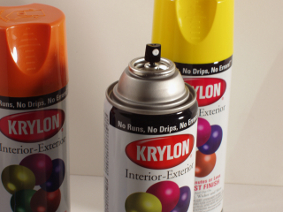Choosing and Using Spray Paint
 Do you find painting with a brush too time consuming? To accomplish tasks in record time, take advantage of the commonly overlooked can of spray paint. Spray paints are not what they used to be -- they're better! Manufacturers have developed high quality formulas that are easy to apply, fast drying, rust-resistant and outstandingly durable. But first, a little knowledge to put in your pocket before you run to the hardware store:
Do you find painting with a brush too time consuming? To accomplish tasks in record time, take advantage of the commonly overlooked can of spray paint. Spray paints are not what they used to be -- they're better! Manufacturers have developed high quality formulas that are easy to apply, fast drying, rust-resistant and outstandingly durable. But first, a little knowledge to put in your pocket before you run to the hardware store:
Choose the Right Spray Paint for the Job
Enamel: Enamel is great for appliances as well as metal cabinets and outdoor tables, providing a hard finish. Use for touch-ups or to recoat as well.
Plastic: Mailboxes, lawn chairs and other plastic items such as planters can be done in an hour or two and colors can be mixed for decorative effects.
High Heat: Best used on grills, stoves or radiators, but do not apply to interior surfaces exposed to flames (that means apply it to the outside of the grill, not to the inside of the grill).
Chalkboard: In addition to children’s rooms, chalkboard sprays can be used to coat poster board, metal or wood and other types of surfaces for a clean-erase finish.
Frosted: Create the look of etched glass on mirrors or doors, and match with stencils for a customized decorative look.
Finish Coating: Apply lacquers in multiple coats to add a high luster finish to all types of items – looks especially stunning on furniture. Urethane coatings can be used over stains or as a protective finish (available in gloss, semi-gloss or satin).
Specialty: Spray paints can be found in specialty finishes including metallic, reflective, antique and stone, in addition to patinas like verdigris, hammered or rust.
A Little Help and a Few Warnings
Many brands have nozzles designed to maximize consistent output and minimize risk of dripping. For a few dollars, you can purchase a snap-on handle to ease hand strain and increase control. Best of all, several finishes do not require a primer coat and can be applied directly to a clean, dry surface. If you do need to prime, however, you can find one-coat primers that aren’t gritty, allowing you to skip pre-sanding before top-coating.
Manufacturers continue to work on developing low-odor formulas, but for the time being, most spray paints are fairly odorous and require proper safety measures. Wear a mask or respirator and protective glasses. Do your spray painting in a well-ventilated area, preferably outdoors. If indoor painting is required, open windows and close doors to contain odor. Never spray paint around children, pets or in enclosed, poorly ventilated spaces!
If you are reading this article because (ahem) you are interested in tagging, heed this warning: Tagging can be dangerous. Want to hear a prohibitive story? In 2009, a man was killed while tagging on a California freeway. The L.A. painter attempted to run across the freeway after he finished spray painting. Unfortunately, he didn't make it.
Tips for Expert Results
1. Prep well! Clean the item to be painted, rinse and dry. If the item is heavily rusted, lightly sand the majority of the rust off and prime the worst areas.
2. Spray paint is developed to be project-specific: Choosing the correct type is one key to success. Follow the manufacturer’s instructions carefully, paying attention to recommended surface prep and dry times between coats.
3. Consider building a home-made spray booth to contain overspray: This can be as simple as a cardboard box with a top, bottom and three sides, or a small frame surrounded by plastic stapled in place. Otherwise, choose an exterior location with a windbreak so specks of dirt won’t become embedded in the wet paint – a garage is perfect!
4. Spray in short bursts to minimize overspray and drips, slightly overlapping from side to side. It’s better to apply lighter coats than to be heavy-handed. Let the spray paint dry well between coats.
5. Tackle large pieces, such as furniture, in sections.
6. Use plastic primer for plastic pieces: For plastic items, such as lawn chairs and mailboxes, use the recommended plastic primer and prepare new surfaces by cleaning with rubbing alcohol or paint thinner.
If you lack the time or inclination to do the painting yourself, hire a professional painter to take care of it for you.
Laura Foster-Bobroff writes for Networx.
Updated January 25, 2018.
Looking for a Pro? Call us (866) 441-6648

Painting Average Costs
Painters Experiences

Unique Painting, Molding And Framing Add Beauty To My Home

Interior Paint Job To Prepare For Move-In Day



